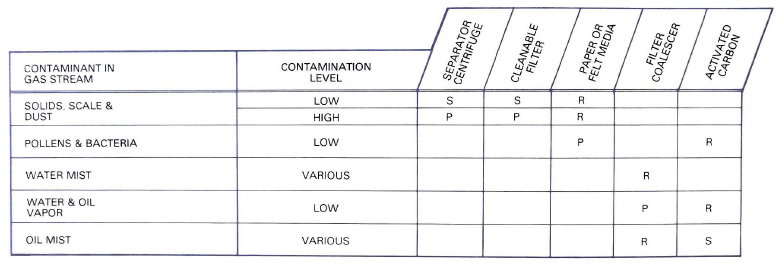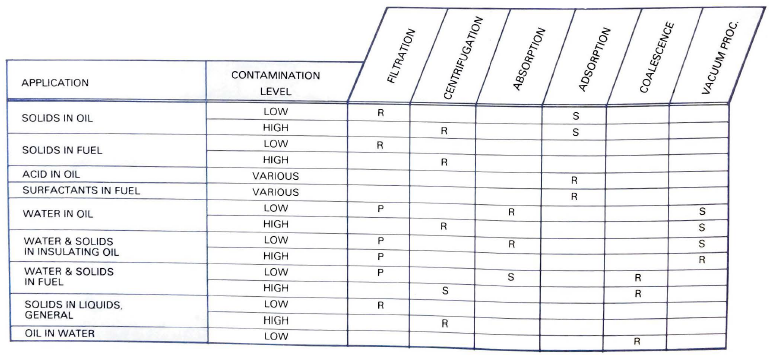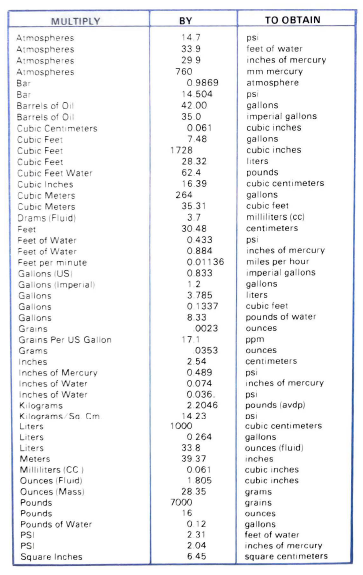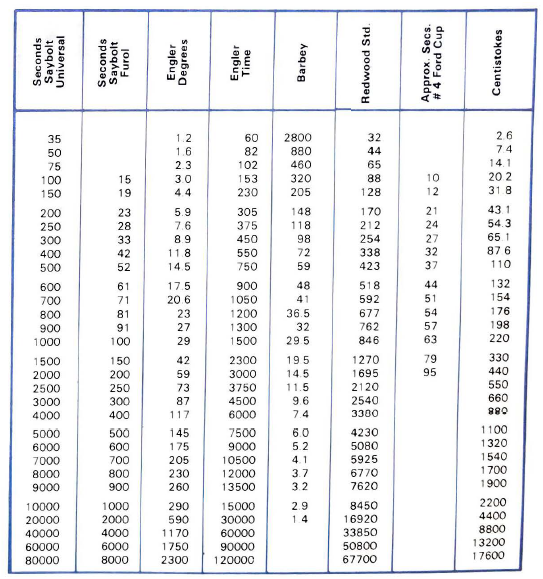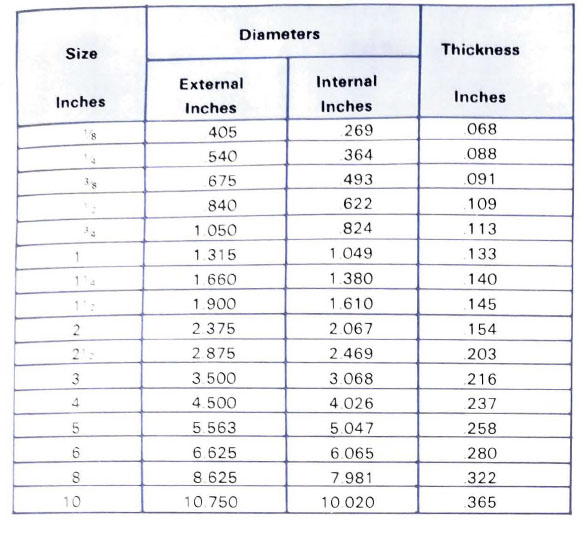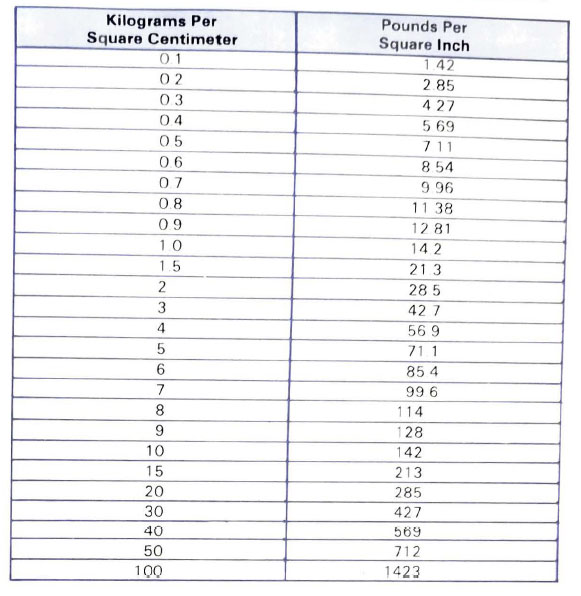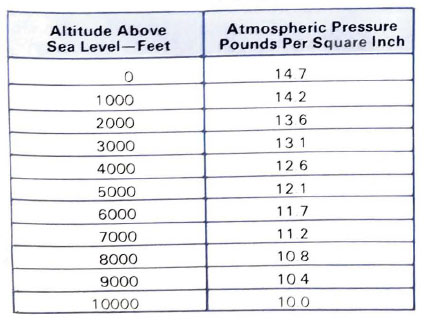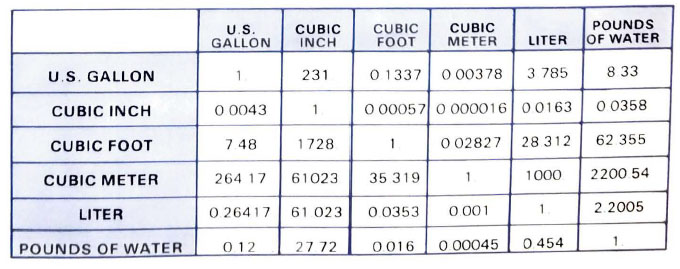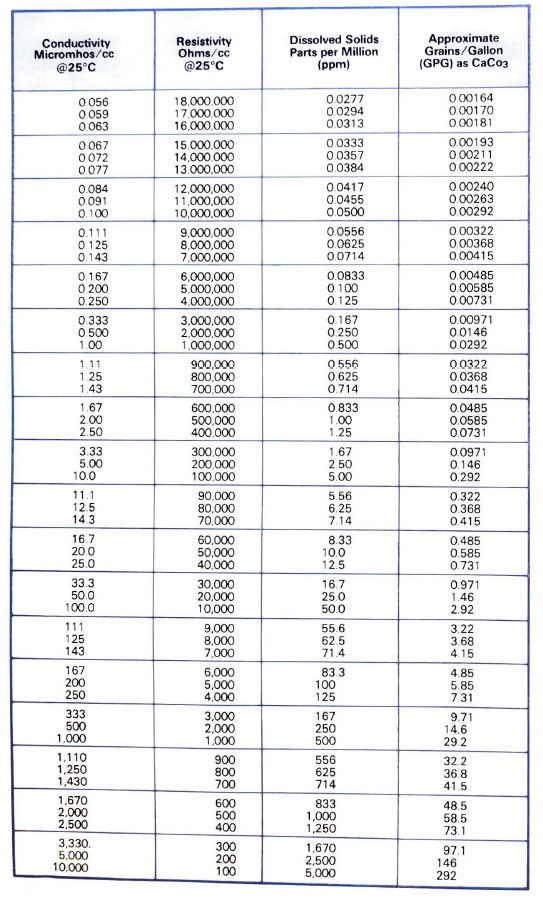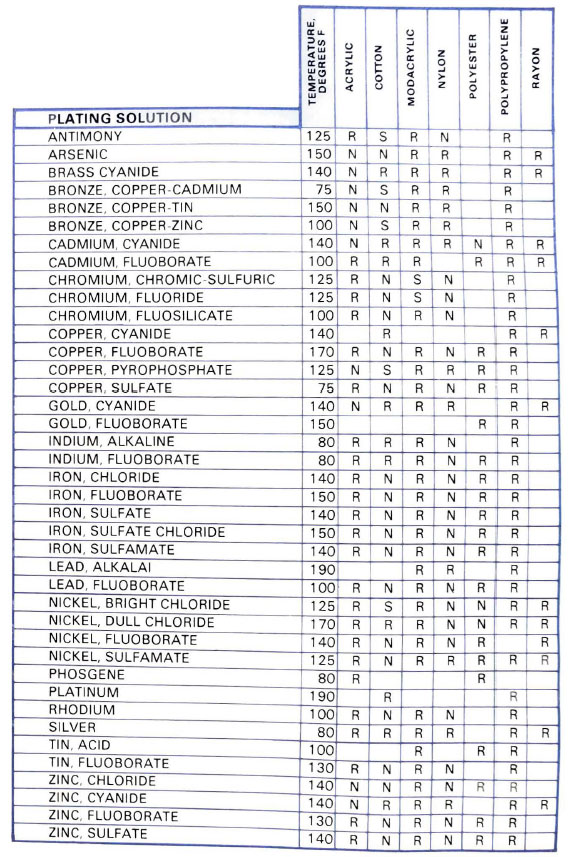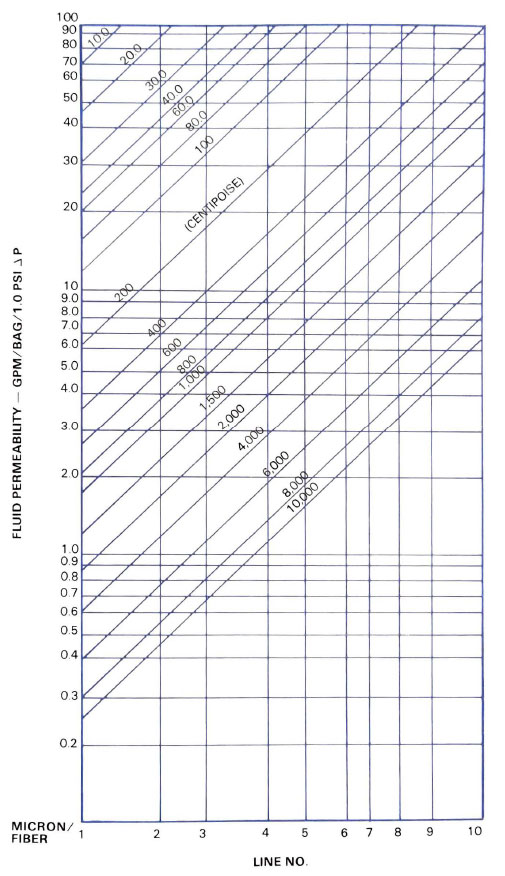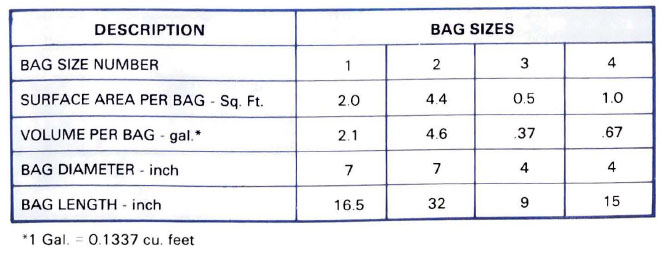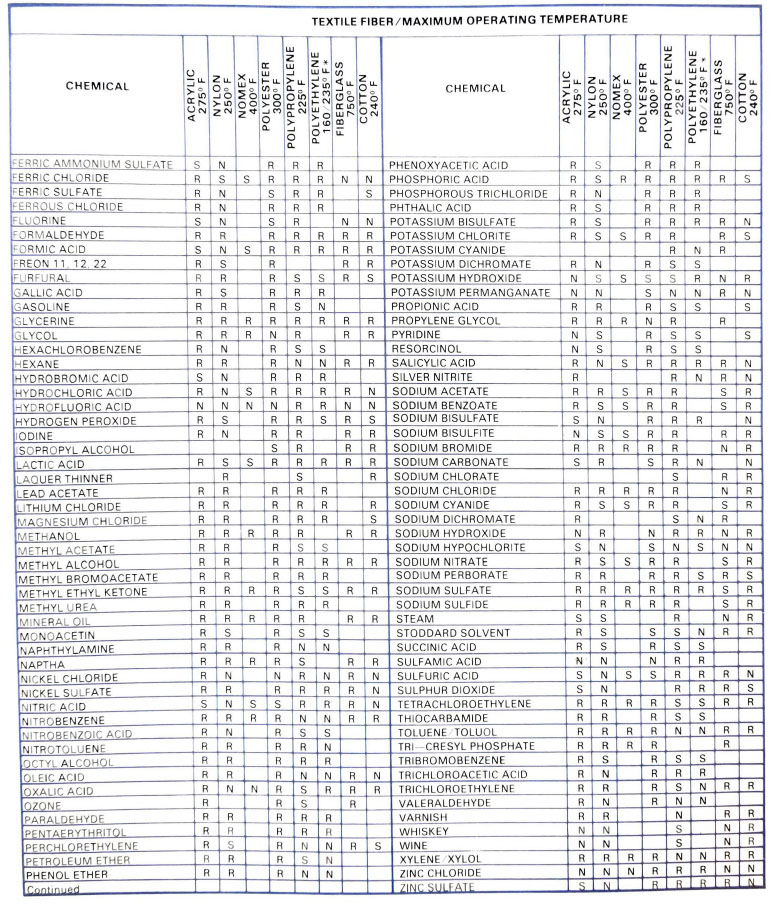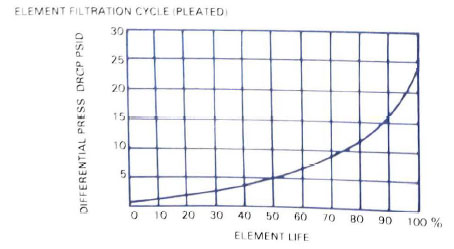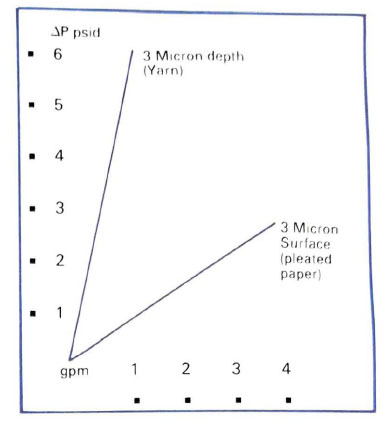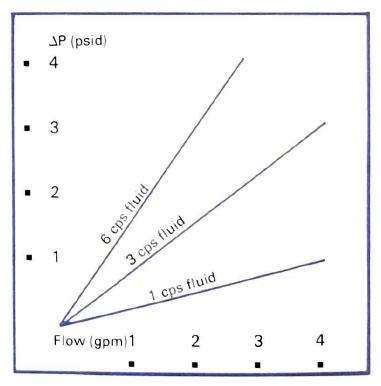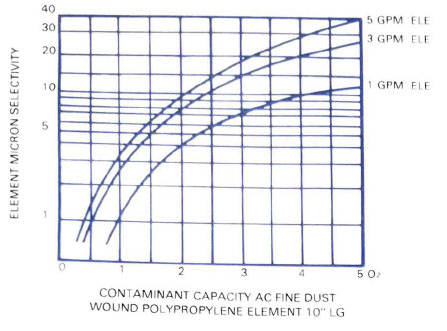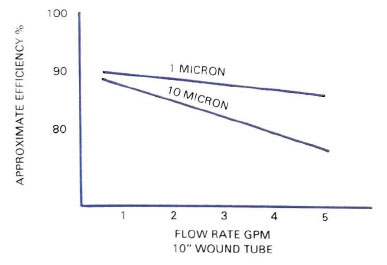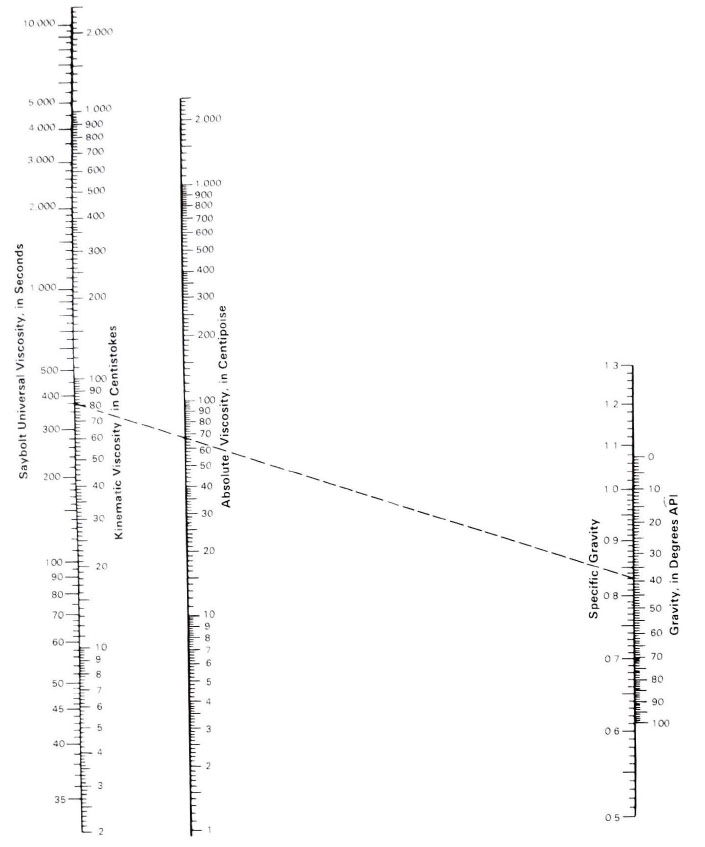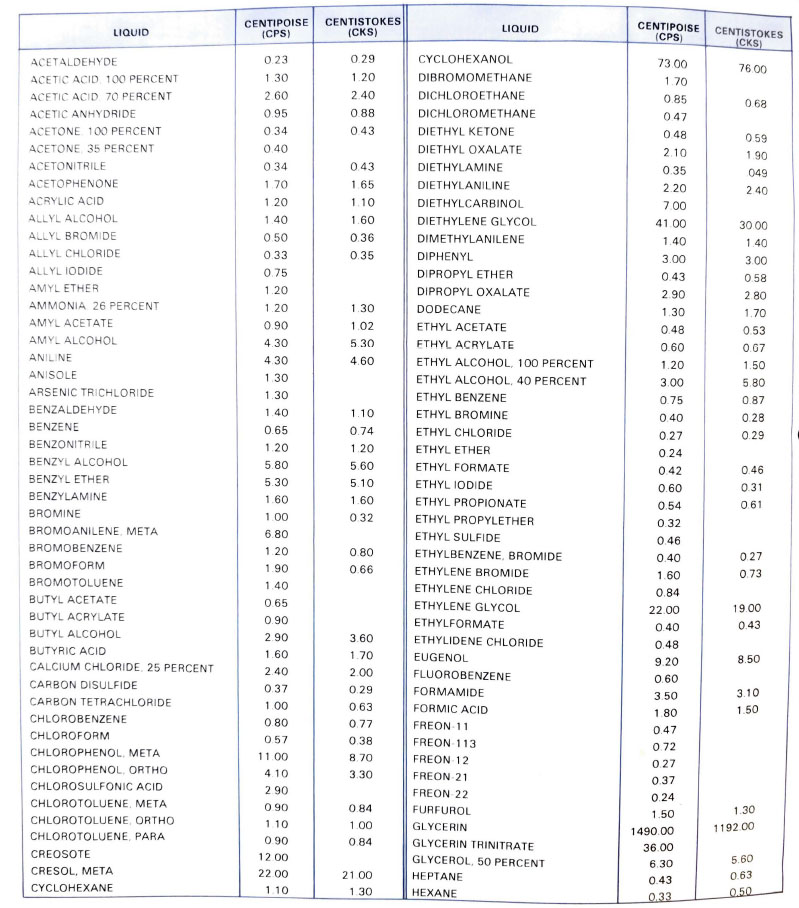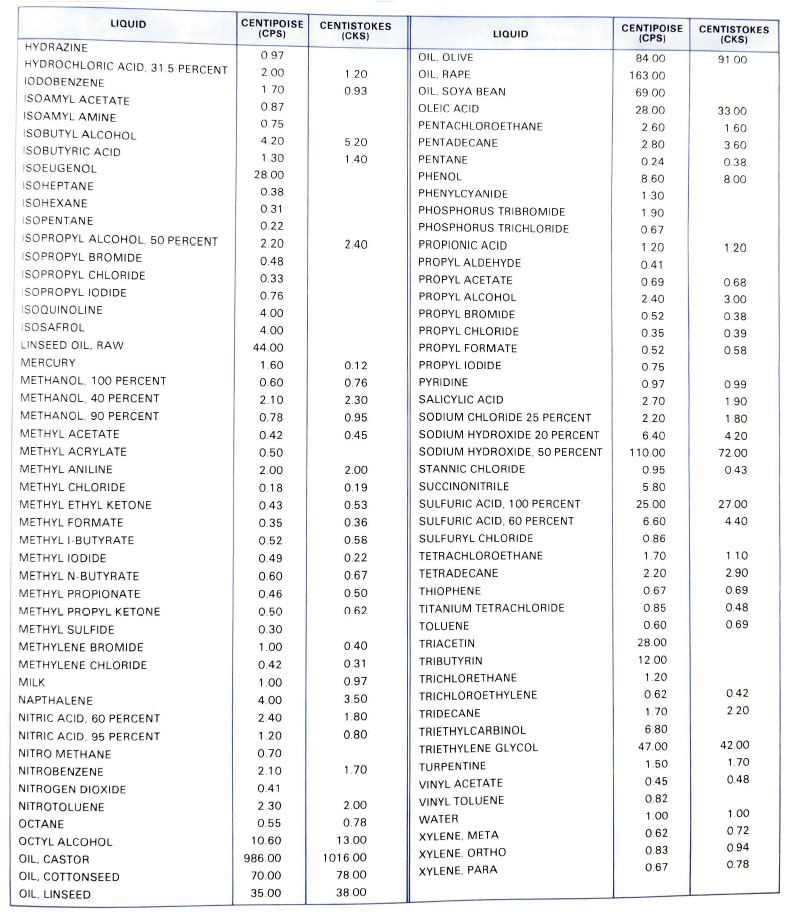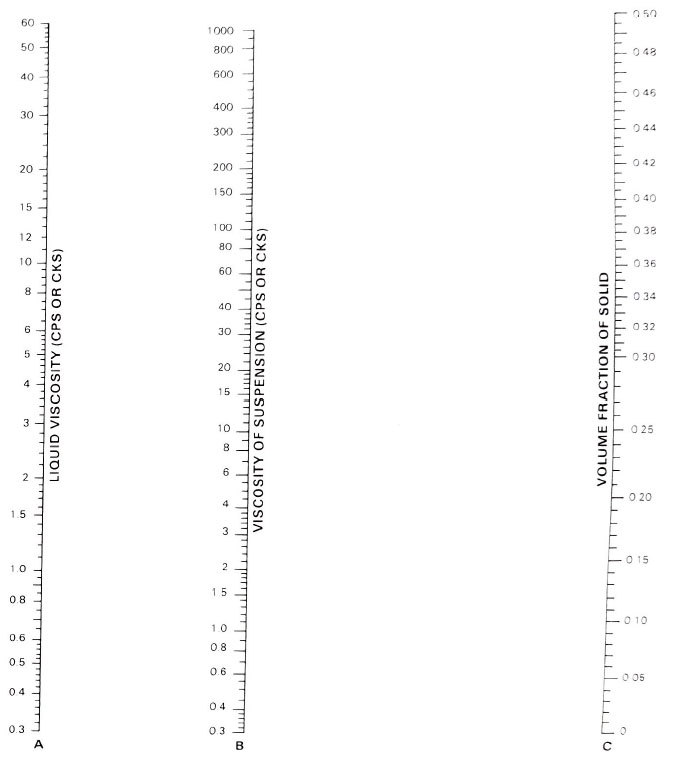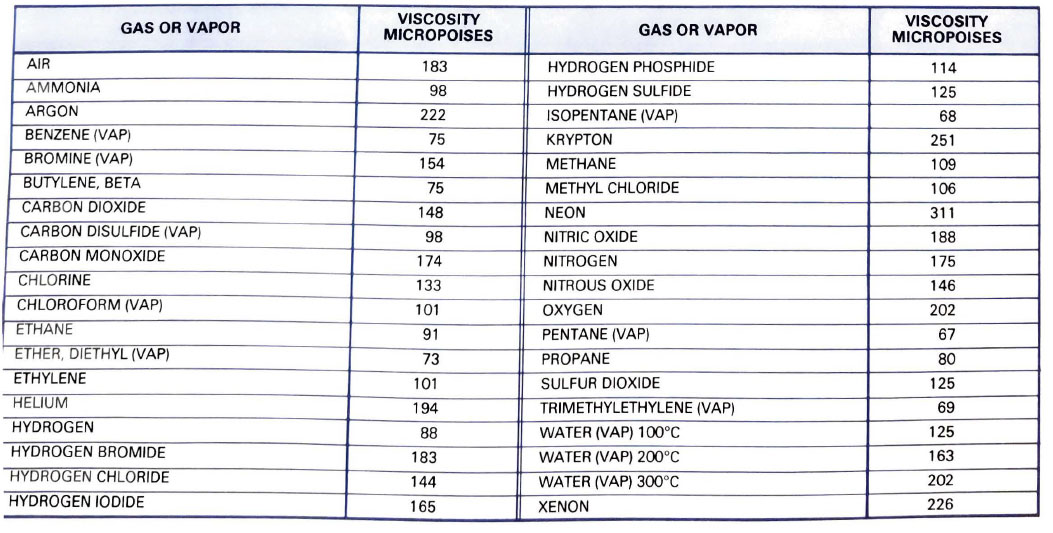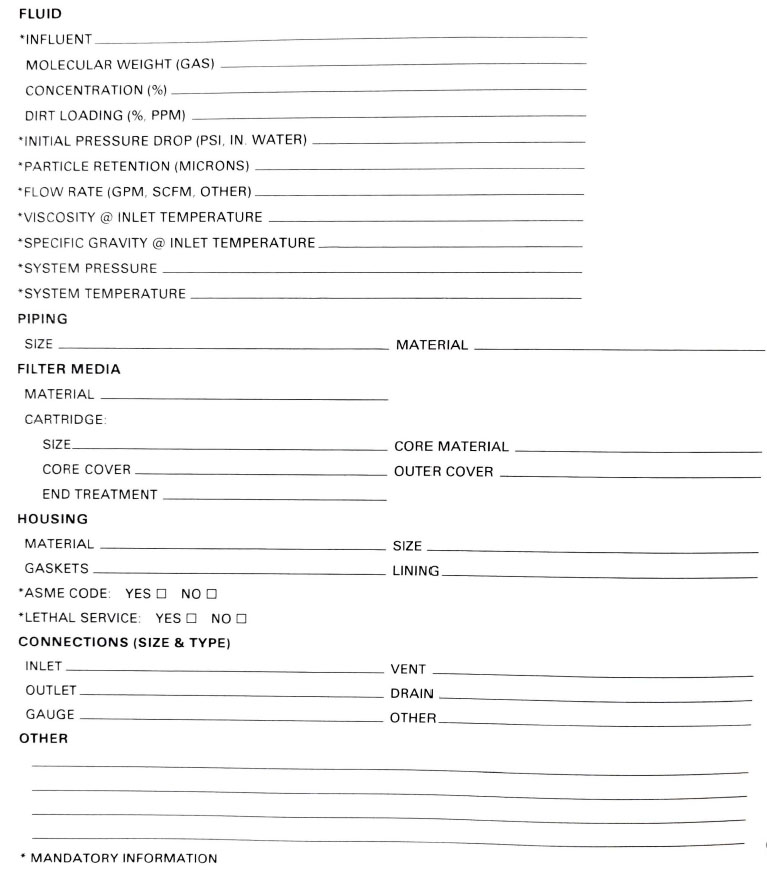SELECTION OF SEPARATION PROCESS BY PARTICLE SIZE & CONTAMINATION LEVEL
SELECTION OF GAS CLEANING EQUIPMENT
SELECTION OF SEPARATION PROCESS FOR GAS APPLICATIONS
CODE: R – RECOMMENDED | P – PREFILTRATION | S – SATISFACTORY
SELECTION OF SEPARATION PROCESS FOR LIQUID APPLICATIONS
CODE: R – RECOMMENDED | P – PREFILTRATION | S – SATISFACTORY
CHARACTERISTICS OF PUMPS FOR FILTRATION APPLICATIONS
Notes on pump applications:
Reciprocating pumps seldom used in filtration systems because of destructive effect of surges on filter media pump life can be prolonged significantly if the pump can be neutralized or flushed with clearwater after each use or at the end of each work day. .
Abrasive or high viscosity slurries require that pump selection and operating speed be given added consideration.
EXPECTED RANGE OF PARTICLE SIZES
APPROXIMATE PRESSURE CONVERSION
GAUGE VALUES
STANDARD SCREEN & PARTICLE SIZE
FINENESS DATA
CONVERSION FACTORS
APPROXIMATE VISCOSITY CONVERSION TABLE
VISCOSITY CONVERSION FACTORS
Centistokes – Centipoise
Specific Gravity
SSU* = Centistokes x 4.55
Degrees Engler* Centistokes x 0.132
Seconds Redwood Centistokes x 4.05
*Where Centistokes are greater than 50
STANDARD PIPE DATA (SCHEDULE 40)
METRIC/ ENGLISH PRESSURE EQUIVALENTS
PARTICLE SIZING TECHNIQUES
DEGREES FAHRENHEIT TO CENTIGRADE
ATMOSPHERIC PRESSURE AT DIFFERENT ALTITUDES
LIQUID MEASURE EQUIVALENTS
DISSOLVED SOLIDS WATER RESISTIVITY / CONDUCTIVITY TABLE
RESISTANCE OF TEXTILE FIBERS TO PLATING SOLUTIONS
CODE: R – RECOMMENDED | S – SATISFACTORY | N – NOT SATISFACTORY | BLANK – INSUFFICIENT INFORMATION
FLOW RATES OF LIQUID FILTER BAGS
Line 1: 1, 3 AP | 1,3 SP
Line 2: 5 AP | 5 SP
Line 3: 10 AP | 10 SP
Line 4: 15 AP | 25 SP | 50 SP
Line 5: 25 AP | 50 AP
Line 6: 75 AP | 100 AP | 100 SP
Line 7: 200 AP
Line 8: 150 thru | 250 Mesh
Line 9: 300 thru | 500 Mesh
Line 10: 600 thru | 800 Mesh
Notes
- NO. 1 SIZE BAG NOT TO EXCEED 90 GPM.
- FOR OTHER THAN NO. 1 SIZE BAG MULTIPLY BY 0.5 X SURFACE AREA.
RESISTANCE OF FIBERS TO CHEMICAL REAGENTS
R – RECOMMENDED FOR MOST CONDITIONS
S – SATISFACTORY FOR LOW CONCENTRATIONS AND TEMPERATURES
N – NOT RECOMMENDED
BLANK – INSUFFICIENT DATA
*LOW DENSITY 160° F
*HIGH DENSITY 235° F
R – RECOMMENDED FOR MOST CONDITIONS
S – SATISFACTORY FOR LOW CONCENTRATIONS AND TEMPERATURES
N – NOT RECOMMENDED
BLANK – INSUFFICIENT DATA
*LOW DENSITY 160° F
*HIGH DENSITY 235° F
PROPERTIES OF INDUSTRIAL GRADE FILTER PAPERS
VALUES ABOVE REPRESENT AVERAGE READINGS AND SHOULD NOT BE USED FOR PRECISE CALCULATIONS.
EXPLANATION OF ABOVE COLUMN HEADINGS
1.) GREAT LAKES FILTER GRADE NUMBER
2.) WEIGHT IN POUNDS PER REAM, 500 SHEETS 20 IN. x 20 IN.
5.) W – WHITE | T – TAN | S – SMOOTH SURFACE | C – CREPED SURFACE
6.) MILLILITERS OF WATER PER MINUTE PASSED THROUGH 1″ DIAMETER SAMPLE WITH CONSTANT 2″ HEAD
7.) HEAD IN INCHES WATER COLUMN REQUIRED TO BURST 1″ DIAMETER SAMPLE
8.) LARGEST SIZE, IN MICRONS, SPHERICAL GLASS BEADS THAT PAPER WILL PASS UNDER STANDARD LABORATORY CONDITIONS
9.) AIR FLOW MEASURED IN CFM AT 1/2″ WATER COLUMN ON FRAZIER PERMEOMETER
FILTER PAPER APPLICATION CHART
* HIGH WET STRENGTH PAPERS SHOULD BE AVOIDED CERTAIN NON-WOVENS CAN PROVIDE ADEQUATE BACK-UP
Grades Should Not Be Considered As Specific Recommendations But Only As A Guide to Selection
RELATIVE FLOW RATE TABLE CELLULOSE FILTER PADS
PROPERTIES OF PADS COMPARED TO PAPERS
- SUPERIOR PARTICLE RETENTION
- HIGHER FLOW RATES
- GREATER DIRT HOLDING
- MORE COSTLY
PERFORMANCE CHARACTERISTICS OF FILTER CARTRIDGES
WHEN TO USE CARTRIDGE FILTRATION
CARTRIDGE FILTERS CAN BE USED WITH LIQUIDS OR GASES OVER A WIDE RANGE OF PROCESSING CONDITIONS. PROPER CARTRIDGE APPLICATION CONDITIONS GENERALLY INCLUDE:
- REMOVAL RATINGS FROM .2 TO 500 MICRONS.
- SYSTEM PRESSURES FROM A NEAR VACUUM TO SEVERAL THOUSAND PSI.
- VISCOSITIES TO 100,000cps
- TEMPERATURES FROM NEAR ABSOLUTE ZERO TO 1000 °F.
- FLOW RATES TO SEVERAL THOUSAND GPM OR SCFM
WHEN TO CHANGE CARTRIDGES*
LITTLE ADDITIONAL USEFUL LIFE IS ACHIEVED BY OPERATING CARTRIDGES BEYOND P=35 DISADVANTAGE OF EXCEEDING P =35 IS POSSIBLE CONTAMINATION OF FILTRATE
SURFACE VERSUS DEPTH FILTRATION
COMPARISON OF FLOW RATE VS . PRESSURE DROP FOR DEPTH AND SURFACE ELEMENTS.
PRESSURE LOSS DUE TO VISCOSITY
CARTRIDGE PRESSURE DROP VARIES LINEARLY WITH FLOW RATE AND VISCOSITY.
IMPORTANCE OF LOW INITIAL PRESSURE DROP
APPROXIMATELY ½ OF THE USEFUL LIFE OF A FILTER ELEMENT IS LOST BY SELECTING A SYSTEM WITH AN INITIAL PRESSURE DROP OF 5 PSIG AS COMPARED TO 1-2 PSIG .
PARTICLE RETENTION EFFICIENCY
COMPARISON OF THE THREE TYPES OF MEDIA INDICATES THE DIFFERENT CUT OFF CHARACTERISTICS. THE DEPTH ELEMENT RETAINS MORE PARTICULATE SMALLER THAN ITS RATED SIZE WHILE ALLOWING PASSAGE OF SOME LARGER PARTICLES .
DIRT HOLDING CAPACITY
DIRT HOLDING CAPACITY IS GREATER FOR HIGHER MICRON RATED ELEMENTS THAN FOR THOSE OF TIGHTER SELECTIVITY.
CURVES ALSO ILLUSTRATE THAT ELEMENTS WILL CAPTURE MORE DIRT AT LOWER FLOW RATES .
FLOW RATE AFFECTS PERFORMANCE
PERFORMANCE OF A CARTRIDGE IS INFLUENCED BY FILTRATION VELOCITY, EFFICIENCY TENDING TO FALL OFF AS THE FLOW RATE INCREASES.
AFFECT IS GREATER FOR HIGHER MICRON RATED TUBES.
*SUGGESTED REPLACEMENT PRESSURE DROP
- PLEATED PAPER ELEMENTS – 20-25 PSID
- WOUND ELEMENTS (UNRESINATED) – 30-35 PSID
- WOUND ELEMENTS (RESINATED) – 50-70 PSID
- AIR ELEMENTS – 12-15 PSID
- COALESCER ELEMENTS – 15-20 PSID
EQUIVALENTS OF KINEMATIC, SAYBOLT UNIVERSAL AND ABSOLUTE VISCOSITY
Saybolt Viscosities above those shown are given by the relationships:
Saybolt Universal Seconds Centistokes x 4.55
Problem: Determine the absolute viscosity of an oil which has a kinematic viscosity of 82 centistokes and a specific gravity of 0.83.
Solution: Connect 82 on the kinematic viscosity scale with 0.83 on the specific gravity scale; read 67 centipoise at the intersection on the absolute viscosity scale.
PHYSICAL PROPERTIES OF TEXTILE FIBERS (APPROXIMATE VALUES)
A.S.T.M. STANDARD VISCOSITY-TEMPERATURE CHARTS FOR LIQUID PETROLEUM, PRODUCTS (D 341)
CHART B: SAYBOLT UNIVERSAL VISCOSITY, ABRIDGED
APPROXIMATE VISCOSITIES OF LIQUIDS AT 68°F/ 20°C
APPROXIMATE AFFECT OF TEMPERATURE ON VISCOSITY OF LIQUIDS
Use of curve:
1.) Given viscosity in centipoise of a liquid at 68° F, from page 20 or 21, locate viscosity on curve opposite corresponding point on vertical scale (example: 105 CPS)
2.) Establish point to right or left for higher or lower temperature differential (example: 150 -68 – 82)
3.) Draw vertical line to curve and read approximate viscosity from vertical scale (approximately 20 CPS)
VISCOSITY OF SUSPENSIONS NOMOGRAPH
A STRAIGHT LINE DRAWN THROUGH POINTS ON LINES A & C WILL DETERMINE APPROXIMATE VISCOSITY OF DISPERSION AT INTERSECTION OF LINE B
FLOW VELOCITY OF LIQUIDS THROUGH PIPES
Reasonable Velocities For the Flow of Water through Pipe
Service Condition | Reasonable Velocity
Boiler Feed | 8 to 15 feet per second
Pump Suction and Drawn Lines | 4 to 7 feet per second
General Service | 4 to 10 feet per second
City | to 7 feet per second
BY DRAWING A STRAIGHT LINE THROUGH TWO KNOWN VALUES ON THE ORDINATE SCALES THE APPROXIMATE VALUE ON THE THIRD ORDINATE SCALE CAN BE DETERMINED
EXAMPLE GIVEN A FLOW RATE OF 100 CFM AND LIMITING VELOCITY OF 5 FEET PER SECOND, CONSTRUCT A STRAIGHT LINE THROUGH THESE TWO POINTS AND EXTEND IT TO INTERSECT PIPE SIZE SCALE AT APPROXIMATELY 3 IN DIAMETER
APPROXIMATE VISCOSITIES OF GASES AT 20°C (68°F)
EQUIPMENT AND MEDIA SELECTION QUESTIONNAIRE
GLOSSARY OF FILTRATION TERMS
ABSOLUTE RATING – The size in microns of the largest hard, spherical particle that will pass through the filter element.
ABSORB – To soak in. as a sponge soaks in water.
ACTIVATED CARBON – Carbon activated by high temperature to form a material of high adsorptive capacity.
ACTUATION PRESSURE – The preselected PSID setting of a differential pressure indicator at which the signal button actuates.
ADSORB – Attracting and holding a gas. vapor. or liquid on the surface of a solid.
ADSORBENT -A solid material which adsorbs, such as clay, carbon. activated alumina.
AEROSOL – A dispersion of small particles in a gas.
AGGLOMERATE – A cluster of particles more or less fixed firmly to one another as by sintering or growing together.
AMBIENT – The term used to present a generalised description of an environment e.g. ambient temperature. The localised atmospheric environment.
AMORPHOUS – Non-crystalline, having no definable form.
ANION – Negatively charged ion, i.e. an atom or molecule which has gained one or more electrons in an electrolyte. It travels to the positive electrode-anode- on electrophoresis or electrolysis. Anions include all nonmetallic ions, acid radicals and the hydroxyl ion (OH). (See “ION EXCHANGE” )
ASBESTOS – A natural group of magnesium silicate materials found in fibrous form.
ATTRITION – Loss of material due to wear caused by rubbing or friction.
BACKWASH – To reverse fluid flow through the filtration media resulting in solids removal.
BAR – A unit of pressure One (1) Bar = 14.5 PSI.
BAFFLE – A plate protecting filter elements from the velocity of flow entering vessel.
BETA RATIO – The ratio of the number of particles of a specified micrometer in the influent fluid to the number of particles the same micrometer in the effluent fluid.
BLEED – The extraction from any circuit of a proportion of the throughput for sampling, quality control, recirculation or process control.
BLIND SPOTS – A place in the filter media where no filtration takes place.
BLINDING – Reducing or shutting off of flow due to closing pores in the filter media.
BLOWDOWN – The use of pressure to remove liquids and/ or solids from a vessel.
BRIDGING – Particles being removed arch over individual openings in the filter media or between the individual filter septa .
BUBBLE POINT – The differential gas pressure which when applied to a filter element submerged near the surface of a test fluid causes the first steady emission of gas bubbles from the filter element . A means of verifying the micron rating .
BUNA N – A Nitrile Rubber seal compound. This is a generic term covering many formulations.
BURST STRENGTH – The ability of a filter medium such as a filter paper to resist disruption by pressure applied in a direction normal to the surface
BYPASS VALVE (RELIEF VALVE) – A valve mechanism that assures system fluid flow when a preselected cl1fferent1al pressure across the filter elements is exceeded.
CAKE – Solids deposited on the filter media.
CAPACITY (DIRT HOLDING CAPACITY) – The quantity of contaminant that a filter element is capable of retaining without exceeding a specified differential pressure at rated flow.
CASE SHUT-OFF VALVE – An optional design feature of filter assemblies which allows the case and element to be removed without draining the system.
CATION – A particle carrying a positive charge which in an electrolytic process moves toward the cathode. It may refer to a positive ion, molecule or a radical. (See “ION EXCHANGE” )
CELLULOSE – A fibrous material of vegetable origin.
CELLULOSIC MEDIA – Compact structures of fibers, basically cellulose, impregnated with resin for strength, rigidity and fluid compatibility.
CENTER TUBE – A support device designed to support the filter medium in a filter element while permitting fluid flow and resisting element collapse.
CENTIPOISE – A unit of absolute viscosity. One centipoise equals .01 poise.
CENTISTOKE – A unit of kinematic viscosity One centistoke equals .01 stoke.
CENTRIFUGE – A machine designed to subject material held in it or being passed through it to centrifuge force. Separation is thus achieved due to any difference in density i.e. accelerated sedimentation.
CLARITY – Clearness of a liquid measured by the amount of contaminants remaining.
CLAY – A natural occurring material usually being activated and used as an adsorbent.
CLEANABLE FILTER ELEMENT – A filter element which upon reaching predetermined differential pressure can be cleaned to an acceptable level of performance for re-use in its fluid system.
COALESCER – Means of causing the disperse phase of two liquids to combine into discrete droplets which. by reason of a difference in density compared with the continuous phase, will separate. Coalescer / separators are widely used for separating water from petroleum fuels.
COLLAPSE PRESSURE – The minimum differential pressure that a filter element is designed to withstand without permanent deformation.
CONTAMINANT – Undesirable solid, liquid or gaseous material present in the liquid or gaseous medium.
CONTAMINANT CAPACITY – The resultant weight of a contaminant (usually A -C fine test dust) which when added at specified intervals and at a specific flow rate produces a differential pressure across a filter element which can be converted or related to the useful life of a filter element.
CONVOLUTING – The accordion pleating of filter media to obtain a large effective filtration area in a minimum volume.
CYCLE – Filtration interval; length of time filter operates before cleaning.
DELTA P – Pressure drop, differential pressure.
DEGREE OF FILTRATION – A measure of the efficiency of filter element expressed in terms of percentage retention of standard contaminants under defined test conditions (Nominal Rating); and the size in microns of the largest hard spherical particle that will pass through the filter element (Absolute Rating). . .
DENIER – A unit of size of textile thread . The basis is that 450 metres have a standard weight of 0 .05 gm. Of significance in describing filter fabrics.
DEPTH FILTRATION – Fluid flowing through a mass filter media following a tortuous path with many entrapments.
DEWATER – Removal of water from solids.
DIFFERENTIAL PRESSURE – The difference in pressure between two points in a fluid system usually in filtration systems expressed as ..P between a housing inlet and outlet.
DISC PACK ELEMENT – Filter element constructed by packing alternate discs of filter medium and flow distributor plates into a compact cylindrical form.
DISPOSABLE FILTER ELEMENT – A filter element which is not cleanable and is therefore discarded and replaced at the end of its useful life. (Sometimes referred to as throwaway or non-cleanable element.)
EDGE TYPE FILTER – A filter which entraps particles on the edges of the medium.
EFFECTIVE FILTRATION AREA – That area of the fluid medium in a filter element which is exposed to flow.
EFFICIENCY – The ability of a filter element to remove/reta in a specific artificial contaminant in a specified concentration under controlled test conditions. Efficiency is expressed in percent.
EFFLUENT – The discharged liquid from a filter, filtrate.
FILTER AID – Powders added to the liquid to be filtered in order to increase the porosity of the cake of solids formed on the filter septum thus maintaining the permeability and the flow of filtrate, lengthening the operating cycle
FILTER ASSEMBLY – A filtering device consisting of a housing and filter element which directs flow from an inlet port, through a filter element and through an outlet port.
FILTER ELEMENT – A porous device which performs the actual filtration process.
FILTER MEDIA – The porous structures upon which, or in which, fluid system contaminants are trapped.
FILTRATE – The liquid which has passed through the filter, effluent.
FILTRATION – The process of separating a solid from a liquid or gas by a porous substance through which only the flu id passes
FINES – Particles which are smaller than a specified size.
FLOW FATIGUE RESISTANCE – The ability of a filter medium to resist structural failure or deterioration from cyclic loading.
FLOW RATE – The rate at which a fluid is passed through a system.
FLUID – A gas or liquid.
FLUID COMPATIBILITY – The suitability of filtration media and seal materials for service with the fluid involved.
FULLER’S EARTH – Clay; a hydrous aluminum silicate.
GPH – Gallons per hour.
GPM – Gallons per minute.
HYDROPHILIC – Water wetting.
HYDROPHOBIC – Water reject ing.
IMPREGNATION – The infusion or saturation of a material with resin.
INFLUENT – The fluid entering a filter.
INLINE TYPE FILTER – A Filter Assembly whose inlet, outlet, and Filter Element have a common centerline.
ION – Any atom or molecule which has a resultant electric charge due to loss or gain of valence electrons.
ION EXCHANGE – The use of zeolites, artificial resins or immiscible liquids to capture anions or cations from solutions Industrial applications include water softening, desalination and purification, solvent extraction, isotope separation and the extraction of metals from ores.
KINEMATIC VISCOSITY – The ratio of absolute viscosity (poise) to the specific gravity of a flu id. The unit of kinematic viscosity is the stoke.
L-TYPE FILTER – A filter assembly in which the inlet and outlet ports are positioned at 90° to each other.
LEAF – A support for the filter medium.
LIQUOR – Material to be filtered.
MEAN FILTRATION RATING – A measurement of the average pore size of the specific filter medium.
MEDIA MIGRATION – Separation and/ or deterioration of components of the filter medium and subsequent release into the effluent.
MEDIUM – The porous material that performs the actual process of filtration
MEMBRANE – A thin permeable film of inert polymeric material cast in such a way, from a mixture of solvents, so that the size, number and shape (tortuosity) of the pores is controlled.
MESH – Number of openings in a lineal inch of cloth.
MICROMETER OR MICRON – A unit of length. A micrometer is one millionth of a meter or 0 .000039″ (39 millionths of an inch). Expressed in convenient terms 25 Micrometers approximately equal one thousandth of an inch ( 001 ” ).
MULTI-PASS TEST – A test used to determine the Beta Ratio of a filter element.
NEGATIVE PRESSURE – Vacuum or suction.
NOMINAL FILTRATION RATING – An arbitrary micrometer value established by a filter manufacturer as an indication of filtration capability.
PARTICLE SIZE DISTRIBUTION – The distribution obtained from a particle count grouped by specific micron sizes.
PERMEABILITY – The relationship of flow per unit area to differential pressure across a filter medium.
PHOSPHATE ESTER BASE FLUIDS – Fire-resistant hydraulic fluids.
POISE (ABSOLUTE VISCOSITY) – Numerically equal to the force required to move a plane surface of one square centimeter over another plane surface at the rate of one centimeter per second when the surfaces are separated by a layer of fluid one centimeter in thickness (dyne sec/ cm2) .
PORE – A small channel or opening in a filter medium which allows the passage of fluid.
PORE SIZE DISTRIBUTION – The ratio of the number of holes of a given size to the total number of holes per unit area expressed as a percent and as a function of hole size.
POROSITY – The ratio of pore volume to total volume of a filter medium expressed as a percent.
PREFILT – Material to be filtered.
PSIA – Pounds per square inch absolute = PSIG (Gage)+ atmospheric pressure (14.696).
PSID – Pounds per square inch differential, P.
PSIG – Pounds per square inch gage = PSIA minus atmospheric pressure ( 14. 696). That pressure registered on a conventional type gauge.
RATED FLOW – The optimum flow rate for which a filter is designed.
RECYCLE – The return of filtered liquid for another filtering.
REVERSE OSMOSIS – The reverse of natural osmosis achieved by external application of sufficient reverse pressure to ca use solvent flow in its unnatural direction through a membrane, that is from the more concentrated to the dilute solution.
SCFM – Standard cubic feet per minute, i.e., units of gas flow rate. A standard cubic foot is measured volume of gas, 760 millimeters of mercury pressure (1 bar) and 0°C temperature.
SEMI DEPTH TYPE FILTRATION – The retention of contamination both on the surface and within the internal pore structure of the medium.
SEPTUM – Support for filter aids.
SINTERED FILTER MEDIA – Porous media formed by packing and fusing together a thin layer of metal or plastic particles or fibres.
SLURRY – Filter feed material in which the solids content is appreciable, such that the solids can easily be seen.
SPECIFIC GRAVITY – The ratio of the weight of a given volume of matter to the weight of an equal volume of water.
SSU = SAYBOLT SECONDS UNIVERSAL – A measure of viscosity. The time in seconds for 60 cubic centimeters (cc) of liquid to flow through a standard orifice at a specific temperature.
STRAINER – A coarse or relatively open filter element usually greater than 50 micron.
SURFACE TYPE FILTRATION – A filter medium which primarily retains contaminant on the influent face.
SYSTEM SILTING – The agglomeration and settling of ultrafine particles in a fluid system.
TEE TYPE FILTER – A filter assembly whose inlet and outlet ports are on a common center line at right angles to the axis of the filter element. Features element replacement without disturbing system connections.
TORR – The unit of pressure used in vacuum measurement; equal to 1 / 760 of a Standard atmosphere.
UNLOADING – The removal of a contaminant which was previously trapped or retained by the filter medium.
VISCOSITY – A measure of the internal friction or the resistance of a fluid to flow. The standard unit of measure is poise, stoke or SSU.
VOIDS – The openings in a medium or filter cake.
WIRE CLOTH – A metallic filter medium formed by weaving fine wires into a cloth with a controlled pore size.
Suggested additional sources of information:
CHEMICAL ENGINEERS’ HANDBOOK, Perry & -Chilton, McGraw -Hill
FILTRATION UPDATE 1983, Ivan Bartik, Technical Monograph
FILTER AIDS AND MATERIALS, Driscoll, Noyes
FLOW OF FLUIDS THROUGH VALVES, FITTINGS & PIPE, Technical Paper #410, Crane Co.
HACKH’S CHEMICAL DICTIONARY, Grant, McGraw-Hill
HANDBOOK OF CHEMISTRY AND PHYSICS, The Chemical Rubber Company
HANDBOOK OF FILTRATION, Eaton-Dikeman Company
HANDBOOK OF SEPARATION TECHNIQUES FOR CHEMICAL ENGINEERS, Schweitzer, McGraw-Hill
MEMBRANE FILTRATION, Brock, Science Tech
PUMP SELECTION, Rodger Walker, Ann Arbor Science
SOLID/ LIQUID SEPARATION EQUIPMENT SCALE-UP, Uplands Press
SOLID/ LIQUID SEPARATION TECHNOLOGY, Uplands Press
GREAT LAKES FILTER provides the best selection of filters available:
AIR MAZE– Filters, air/oil separators and breathers
FILTERITE – Vessels and tubes
BRUNSWICK Membrane Products
DYNALOY Metallic elements
ION EXCHANGE PRODUCTS
Cyclonic Separators
Filter Presses-Cloth, paper and pads
Dust Collector Bags
Liquid Pressure Vessels and Bags
Oil/Water Coalescer Separators
Oil Reclamation Systems
Custom Bags
Air Filters
Replacement Elements
Coolant Media
Sand Filters
Screens and Strainers
Flex-Sock Connectors for Screeners
Laboratory and technical assistance readily available …
Our engineers make house calls
FILTRATION APPLICATIONS FOR INDUSTRY
Click Here to Download PDF Version of Engineering Filtration Data
Click Here to Download PDF Version of Glossary of Filtration Terms


